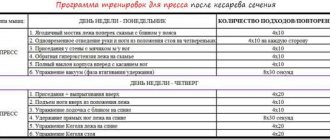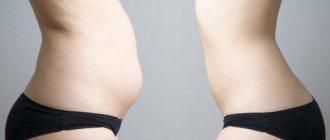2133
One of the main aesthetic problems of a young mother is excess weight and changes in her figure in the waist area. As practice shows, in the first days after a cesarean section a woman manages to lose 5 to 9 kg, and after a year the weight should approach the pre-pregnancy level. If you can’t achieve the desired results, and the indicators on the scales are disheartening, it’s time to take the advice of experts. They know how to lose weight after a cesarean section and regain your former slimness in the shortest possible time.
Why does excess weight persist after childbirth?
Excess body weight after childbirth is normal, because the physiological accumulation of calories contributes to effective breastfeeding. If a woman does not breastfeed her baby, and the weight does not go away for two years after giving birth, it is necessary to identify and eliminate the causes of such stagnation.
- Hormonal imbalance. During pregnancy, the endocrine system intensively produces hormones that contribute to a successful pregnancy. If after childbirth the balance of hormones in the blood does not return to the “pre-pregnancy” norm, there is reason to suspect a disorder. Additional signs of imbalance will be frequent headaches, hair loss or excessive hair growth, and mood swings.
- Sleep deficiency. A small child sleeps restlessly at night, suffers from colic, or is simply capricious. The young mother, who feels tired and depressed the next morning, also does not sleep with him. During the day, the body will try to replenish energy costs by storing calories from nutritious meals.
- Passive lifestyle. With the arrival of a baby in the family, a woman has a lot of troubles, while there is a catastrophic lack of time for full-fledged sports. There can also be problems with motivation, because lack of sleep and fatigue leave no strength or desire to exercise.
- Daily routine. The whole life of a young mother is focused exclusively on the newborn, while meetings with friends, going to the cinema and theater are relegated to the background. The lack of new impressions and communication leads to the fact that a woman seeks to gain pleasure through food, pampering herself with desserts and carbohydrate-rich dishes.
Only the first case requires professional medical care. An endocrinologist will study hormonal levels and formulate treatment tactics. In other cases, the initiative is in women’s hands - a properly structured daily routine and nutrition will help you quickly lose weight after a cesarean section.
Causes of abdominal deformity after cesarean section
Before you try to eradicate the problem, you need to find out its original source. It is a common misconception that women who have children without obstetrics are much less likely to develop an ugly belly ridge. Partly, the fact that during cesarean section the “solidity” of the muscles is disrupted gives the above-mentioned statement the right to exist. If the surgical incision was made carelessly, with damage to muscle tissue, then it will be very difficult to regain a flat tummy. But attributing extra centimeters to the inexperience of doctors today is a stupid idea, given how many times a day gynecological surgeons have to perform cesarean sections.
Do you have complexes because of your appearance?
Not really
Of course, for some time after the baby is removed from the uterus surgically, a fatty “apron” hangs over the scar due to impaired loss of fluid from the tissues. But if it does not go away even several months after the woman is discharged from the maternity hospital, it is worth looking for another justification for the occurrence and persistence of the defect:
- Reason #1 – extra pounds. Weight gain during pregnancy is inevitable, no matter what diets and physical exercises the expectant mother exhausts herself with. Fat deposits are mainly localized on the buttocks, hips and waist. But here it is important not to cross that fine line between normal and excess, otherwise it will be almost impossible to remove the belly after a cesarean section.
- Reason No. 2 – changed posture. While carrying a child, a woman constantly slouches. Because of this, the lower back bends, the abdominal muscles relax, and a layer of fat appears. And after giving birth, a young mother often spends time with the baby in her arms. As a result, the cushion formed as a result of the operation remains in place.
- Reason #3 – stretched abdominal muscles and skin. The pressure to which the abdominal walls are exposed during the period of pregnancy by the mother affects the condition of the abs. Let's not write off such a phenomenon as diastasis. It is noteworthy that in the body of the expectant mother, the production of relaxin increases, which increases the elasticity of connective tissue, relaxes the muscles, and promotes the divergence of the rectus peritoneum muscles.
It is important to mention one of the main factors that is accompanied by a bulging tummy - the uterus enlarged during fetal maturation. During 40 weeks of pregnancy, it grows 500 times. Of course, for this organ to return to its original state, it takes a lot of time - at least 45 days. Before the expiration of this period, the figure of a woman in labor that does not fit into generally accepted standards of beauty is quite normal.
It’s rare, but there are lucky women who, in order to get rid of extra centimeters on the waist and get rid of the belly after a caesarean section, do not have to make even minimal efforts - everything gradually goes away by itself. But more often than not, regaining the “pre-pregnancy” slimness is not as easy as we would like.
Sports approach
Exercise is a great opportunity to get rid of extra pounds. But do not forget that a cesarean section is an abdominal operation that requires long recovery and certain restrictions on physical activity.
Gynecologists strongly recommend adhering to the following rules:
- Consult a doctor about the permissible exercise regime;
- For 8 weeks after surgery, maintain physical rest, allowing the body to start natural recovery processes;
- In the early postpartum period, the load that the woman will receive in the process of caring for the baby is sufficient;
- 2 months after giving birth, you can begin light gymnastics, excluding squats and running;
- Abdominal training is allowed only 6 months after cesarean section, when the abdominal muscles have recovered as much as possible and the risk of suture dehiscence has been eliminated;
- All types of loads should be increased gradually, starting gymnastics with warming up the muscles, ending with stretching and normalizing breathing;
- The average training duration is 10 minutes, one lesson three times a week;
- In the first postpartum weeks, you need to take care of the bandage; you need to wear it not only while exercising, but throughout the day.
Be sure to read: How to lose weight with a celery smoothie?
Maintenance exercises after a caesarean section do not have to be complicated. The simplest feasible exercises that will keep the body in good shape will do.
Breathing exercises
This is done as follows:
- Place your palms on your chest, take a deep breath, exhale slowly, trying to slowly help your hands push the air out of your lungs;
- Place your palms in the birth suture area, take a deep breath, filling and inflating your stomach to the maximum;
- After a second, you can exhale, tensing your abdominal muscles;
- Straighten up, count to eight, tensing and relaxing the abdominal muscles on every second count.
Breathing exercises will help restore strength and gain vigor; they relieve tension, relax, and strengthen the muscles of the abdomen and chest.
Let's use the limbs
Exercising your legs and arms is the easiest way to lose weight after a cesarean section. It can be carried out already when the baby is two weeks old:
- Development of the feet - flexion, extension, clockwise and counterclockwise rotation;
- Stretch your legs in front of you, bend and straighten each leg individually several times;
- Exercises for the arms – extension, flexion, shaking, retraction/distraction of the shoulder blades.
The complex can be combined with side turns of the torso. Be sure to monitor your posture - keep your back straight while sitting and standing. This will help tighten your stomach and eliminate tension in your back muscles.
Kegel exercises
A specially developed complex is indicated for women of any age and position. Exercises help strengthen the muscles of the perineum and pelvic floor, support sexual health and prevent inflammation of the intimate area.
Sequencing:
- Contract the intimate muscles for 5-10 seconds, followed by relaxation;
- Alternately tense and relax the muscles of the vagina and anus, creating a wave-like effect;
- Relax, hold your breath and push as if you are having a bowel movement.
All exercises can be performed in a lying, standing or sitting position. Each of them is performed up to ten times in 4 approaches during the day.
Fitball
A fitball, or gymnastic ball, is a great help for young mothers trying to improve their figure. Your doctor should advise you when you can start training on a fitball. You will have to wait up to 3-4 months after childbirth, but most often classes are allowed only six months after a cesarean section.
Gymnastics complex on fitball:
- Jumping on a ball with a straight back. In this case, you need to try not to lift your feet off the floor, and your pelvis from the surface of the projectile.
- Sitting on a fitball. Turn to the sides with legs apart and hands clasped behind the head.
- In a lying position. Lie on your back on the floor, bend your legs at a right angle. Place your hands under your back, palms down, and grab and hold the ball with your feet. Together with the fitball, pull your knees towards your chest, trying to lift your buttocks.
During these workouts, the load on the abdominal cavity will be felt, so exercise on a fitball should be done only after complete restoration of health.
Exercises for the abs
This complex can be connected already at the late postoperative stage - when the baby is at least 6 months old.
Allowed exercises:
- Bridge;
- Plank;
- Deep bends forward;
- Squats;
- Bike.
Yoga, Pilates, water aerobics, swimming, and cycling will help keep your body in shape.
Features of losing weight after surgical delivery
The period after a cesarean section differs from the period after a physiological birth and makes its own adjustments to a woman’s behavior and capabilities. Artificial delivery increases the duration of recovery and implies additional physical restrictions. If the mother does not experience any negative consequences of the operation, on the second day she is recommended to start moving independently: carefully get out of bed and walk a little. You need to lift the child carefully, trying not to strain the abdominal muscles.
In the maternity hospital, a woman must follow a fairly strict diet:
- You should not eat sweets, fried, fatty, spicy foods;
- eat preferably 4-5 times in small portions;
- rough and hard food is completely excluded from the diet;
- you can have fermented milk products, cereals, cutlets and vegetable puree.
If a woman is breastfeeding, then, taking into account all the prohibitions, it is necessary to remember that the diet should be varied and complete to enrich the milk with vitamins and minerals. It is believed that breastfeeding has a positive effect on the body’s recovery process and contributes to weight loss. So, when a baby suckles, the uterus begins to contract intensely, and with the production of nutrient fluid, the extra pounds disappear faster.
After a caesarean section, a woman must follow a diet and avoid exercise for two months.
If the postoperative period is successful, the mother and child are discharged home after 7–10 days. In most cases, the incision is sutured with threads that do not require removal and dissolve on their own within two months. But even at home, a woman needs to follow the doctor’s advice and remember the restrictions.
Women who have given birth on their own can exercise 2–3 weeks after giving birth. Mothers who have had a caesarean section will have to refrain from any physical activity until the suture is completely healed.
Basic recommendations in the first 2 months after surgery
- It is advisable that for 3–4 weeks the parent raises the child independently as little as possible.
- Any hard work and sudden movements should be avoided.
- You can’t exercise deliberately to lose weight. It is forbidden to pump up the upper and lower abs, run, jump, do planks and crunches, push-ups, etc.
- Sexual life is also prohibited.
- Foods that promote gas formation, coarse fibers, as well as sweet, spicy, pickled and fatty foods should be excluded from the diet.
What can you do during the period of suture scarring?
During pregnancy, the condition of the skin often worsens, sometimes it becomes excessively dry, and stretch marks may form. To improve the appearance of the skin, soften it and correct imperfections, use special creams or oils. Of course, you shouldn’t expect miracles even from very expensive products; they won’t be able to completely remove deep defects.
Long walks with a child have a beneficial effect on the physical condition of the mother
Despite the fact that intense physical activity is prohibited, a mother can go for long walks with her child. Fast walking is a fairly effective way to lose weight. In this case, many muscles will be involved and extra calories will be spent. A woman can also do simple tasks like caring for her baby and home, which will have a beneficial effect on her recovery.
Factors influencing the weight loss process
Unfortunately, in women who have had a cesarean section, the abdominal muscles take longer to return to their previous shape. In this case, the following features will be important factors:
- how the pregnancy itself went, are there any complications (for example, sudden weight gain, diastasis of the rectus abdominis muscles or hernia);
- exactly how the incision was made during the operation;
- how carefully the stitches are placed;
- How was the postoperative period?
- what are the resource capabilities of the organism itself?
After two months, you are allowed to start physical exercise, but only after consulting a doctor. It is better to discuss the intensity of the load with a specialist, since a woman may have individual characteristics.
Making a menu
A balanced diet is the basis for excellent well-being and good health. This is an axiom not only for new mothers, but also for all other representatives of the fair half who watch their figure.
Be sure to read: The benefits and harms of pomelo for the body when losing weight
Doctors strongly do not recommend that women following a cesarean section adhere to strict diets and fasting. This is especially important during breastfeeding, when the health of her baby depends on the mother’s nutrition.
The basis of proper nutrition should be animal protein, namely all types of meat and fish. Red meat rich in iron will help increase hemoglobin in the blood, the levels of which after surgery often do not reach normal levels.
The daily diet should include:
- Fermented milk products of natural origin are wonderful probiotics that normalize intestinal microflora, strengthen the immune system and help the body recover after childbirth;
- Non-starchy vegetables and greens - they are rich in plant fiber, which satisfies hunger well with a low calorie content, and also promotes regular bowel cleansing;
- Cereal dishes, bran loaves and gray bread - they contain a high concentration of B vitamins, useful for active metabolism;
- Vegetable oil – you need to add it to salads for better absorption of vitamins and normalization of the gastrointestinal tract;
- Fibrous, unsweetened fruits and berries - saturate the body with vitamins and plant antioxidants, remove toxic compounds and toxins.
Losing weight after a cesarean section involves a regimen of fractional meals. The entire daily food intake is divided into 4-6 times and consumed in small portions throughout the day. It is better to structure the menu in such a way that breakfast includes porridge - the body will receive the required dose of calories in the morning and tune in to a healthy metabolism. The feeling of hunger that arises before bed can be quenched with a green apple or a cup of kefir.
If the baby eats artificial formulas, the mother’s diet will be more varied, since there is no need to fear an allergic reaction from the fragile child’s body.
You will have to lose weight while breastfeeding as part of a more monotonous diet. You will have to forget about sweets with cream and dyes, canned food, spicy dishes, citrus fruits - all those products that can become allergens for babies. The main emphasis will have to be on dietary soups, steamed dishes from vegetables and meat, porridge from oatmeal, buckwheat and rice.
When building a menu, you can rely on the daily calorie intake developed by nutritionists:
- For women leading a sedentary lifestyle, an intake of 1500 kilocalories per day will be sufficient;
- During moderate intensity exercise, you should not consume more than 2000 kilocalories;
- High physical and mental energy costs require an intake of about 2500 kcal from food;
- Nursing mothers can add another 500 units intended for the child to the indicated standards.
Even during breastfeeding, nutrition should not be poor. But new dishes and ingredients should be introduced into the diet with caution, starting with small doses. Observing your child throughout the day will help you understand how the growing body perceives an unusual product.
The first eight days after surgery
During this period after cesarean section, weight loss exercises at home should stimulate metabolism, since due to a sedentary state there is a tendency for it to decrease and become distorted, especially if a woman does not monitor her diet. Metabolism directly depends on the activity of the lymphatic system, so on days when most of the usual physical exercises are not available, you can focus on speeding up metabolic processes. One of the best options in this case is Ujjayi breathing, which is usually used in yoga practice: slow, deep breaths through the nose until you feel a slight expansion of the chest (an indicator that all the lungs are involved) and exhale through a slightly compressed throat (as when swallowing) . The mouth is closed, so the exhalation will be quite long, which, in principle, is what you should strive for. Average guideline: 10-12 seconds to inhale and the same amount to exhale.
Massage
Classic massage techniques include the following techniques:
- Easy kneading;
- Stroking;
- Trituration.
Massage for weight loss can be performed just a few days after surgery. At first, the procedure should be entrusted to a specialist, and after a week you can perform self-massage at home. Hand movements should be very light and careful, not affect the area of the postoperative suture and not cause discomfort. You should move from the navel to the periphery, making circular and spiral strokes.
Be sure to read: Losing 10 kg in 10 days is quite possible
Physical activity
If the postoperative period was successful and the doctor allowed you to exercise, be sure to devote at least some time to sports. The best exercises to lose belly fat after you have had a cesarean section are exercises aimed at strengthening your abdominal muscles. In addition, do not forget that you cannot lose weight without cardio exercise. Being too active after childbirth is not very welcome, but light aerobics is quite acceptable. Dancing, jumping, swimming - all this will help you get in shape faster.
When can you exercise after a caesarean section?
Now let's move on to effective exercises for reducing belly fat and shaping your waist. In this regard, various variations of crunches and planks are considered ideal.
Cold and hot shower
This is a very simple but effective way to lose weight, based on temperature contrast. Why a contrast shower is useful:
- Tones muscles;
- Activates metabolic processes;
- “Accelerates” blood and strengthens blood vessels;
- Helps burn calories;
- Increases the body's resistance to infections.
The procedure should begin with a stream of warm water (temperature about 40 degrees), then connect cold water. It is necessary to maintain such a time interval that the effect of a warm jet is three times longer than the effect of a jet with a low temperature. Finish the session with a cool shower.
To tighten your stomach
In fact, the bodyflex technique is based on the yogic exercise “abdominal vacuum,” which is very popular not only among young mothers, but also among everyone who has extra centimeters in the waist area. After a cesarean section, you can start doing this weight loss exercise no earlier than three months after the operation, since the internal suture should heal well. In order to properly master the abdominal vacuum technique, it is recommended to contact an experienced specialist in this matter, since it has a number of subtleties that not everyone can master at home.
Body masks and scrubs
Topical use of natural ingredients will help achieve a fat-burning effect and tighten the abdominal skin that has lost its elasticity. Components with tonic, nourishing and lipolytic effects will be used:
- Grape juice (5 large spoons), liquid honey (1 teaspoon), a couple of spoons of nourishing body cream;
- Blue cosmetic clay, ground coffee and mineral water in equal proportions;
- 3 teaspoons each of cream and honey, two small spoons of brewer's yeast.
The ingredients for each mask must be thoroughly mixed to a creamy consistency and applied to the skin after taking a hot shower or bath. The exposure time of the product is no more than 20 minutes.
Masks go well with a variety of scrubs. You can also prepare them yourself using natural liquid honey. Substances with abrasive particles are added to it: ground coffee, sea salt, granulated sugar, ground oatmeal, black pepper and cinnamon. Scrubbing sessions are best done during hygiene procedures - right under the shower.
How not to make a mistake
Many women who are interested in how to quickly lose weight after a cesarean section make common mistakes. As a result, they face a number of difficulties that not only prevent them from returning to normal weight, but also cause harm to their health.
- Strict diet. Leads to weight fluctuations, reduces the quality of breast milk, and forces a woman to be in constant stress.
- Obsessive fears. Persistent doubts that the previous weight will not return create a negative emotional background that prevents you from achieving your goal.
- Long-term breastfeeding. Doctors advise stopping breastfeeding when the child turns two years old. During this period, the need for milk is minimal, little energy is spent on its production, so the woman runs the risk of gaining weight.
- Restrictions on rest. The mother's activity and rest regime should coincide with the baby's regime. During the child's nap, a woman should also lie down to rest and not start doing household chores. Otherwise, lack of sleep will negatively affect your diet and can lead to overeating.
- The use of pharmaceutical supplements with a fat-burning effect. Many of the drugs are of dubious origin, and their safety for maternal health has not been proven. Dietary supplements inhibit intestinal function, lead to dehydration and disrupt metabolism, which does not contribute to healthy weight loss.
Gynecologists do not advise young mothers to force things and try to lose excess weight in a few weeks or even months. First of all, you need to wait for the gradual restoration of hormonal balance, which will lead to a natural decrease in body volume, and then begin active actions.
Contraindications
The category of forbidden sports in the first year after a caesarean section includes all outdoor ball games (volleyball, basketball), as well as alpine skiing, long hikes, rafting on mountain rivers, parachute jumping and weightlifting. Excessive load can lead to seam divergence, problems with lactation, and chronic fatigue.
In addition, you should forget about sports until the official permission of the doctor in the following conditions:
- Severe divergence of the pelvic bones.
- Inflammation of the genital organs (endometritis).
- Hormonal disbalance.
- Increase in temperature for no apparent reason.
- Exacerbation of chronic pathologies.
In the first months after birth, good physical activity includes caring for your newborn. Only after six months should you resort to more intense exercise. During this time, the body will recover and it will be easier for the woman to enter the usual sports regime.
Author: Anastasia Sebel, especially for Mama66











